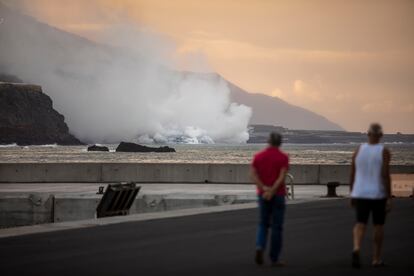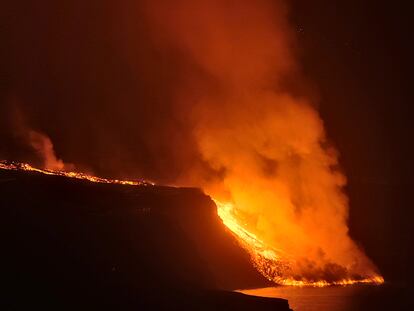Lava from La Palma volcano has already covered five to 10 hectares of the sea
The molten rock has reached 744 buildings on the Canary Island so far, 656 of which have been completely destroyed


Lava from the new volcano on the Canary Island of La Palma finally reached the sea on Tuesday night. The tortuous and haphazard route that it took over the last 11 days has left behind a trail of destruction, and a financial cost that will have to be dealt with over the coming months.
By Wednesday afternoon, the lava had already covered between five and 10 hectares of the sea, according to calculations by EL PAÍS. It measured 500 meters wide, and had changed the color of the water surrounding it, according to Ramón Margalef Eugenio Fraile, from the Spanish Oceanographic Institute (IEO), and who was speaking to Spanish news agency EFE. The lava was spreading bit by bit, and by this morning already measured around 50 meters high, forming a kind of pyramid.
The cost of the destruction in terms of homes and plots of land could be as high as €206 million
By Wednesday, the lava had reached 744 buildings on La Palma, 656 of which have been completely destroyed, and it had covered an area of 267.5 hectares. Meanwhile, 23.1 kilometers of roads had been affected by the molten rock, 21.5 kilometers of which had also been destroyed, according to the latest information from the European satellite system Copernicus. On Wednesday there were major concerns about the connecting roads in the south of La Palma, such as those serving Puerto Naos and La Bombilla.
The regional premier of the Canary Islands, Ángel Víctor Torres, explained during a radio interview today with the Cadena Cope network that there was “huge damage to roads and homes,” but, he said, the “lava now has a route toward the sea.” He added that the tongues of lava should now stop spreading out, meaning that further destruction of property could be minimal.

According to a calculation by the real estate website Idealista, the cost of the destruction in terms of homes and plots of land could be as high as €206 million.
For now, the eruption of the volcano on La Palma “has not affected the air quality, which is perfectly breathable,” according to the island council, which added that measuring equipment had not detected any gases that could be dangerous to people’s health. Despite this, the council requested that residents of Tazacorte stay inside their homes, should any toxic gas be emitted and drift over the island as the lava meets the ocean.
After several days of deceleration, the lava reactivated on Sunday, speeding up its journey toward the sea. Until that point, the eruption had been strombolian, characterized by large explosions and a slow lava flow. At the start of the week, however, much more fluid lava started to emerge from the volcano, speeding up the arrival of the molten rock in the sea.
Spanish Prime Minister Pedro Sánchez, who has already visited the island, announced on Wednesday that he would be returning to La Palma without specifying when. He added that various levels of government are working on approving more assistance for the island’s residents.
The central government has announced that it will be acquiring 107 properties “before the end of the year,” to allocate them to those who have lost their homes.
Transportation Minister Raquel Sánchez said that she will also be traveling to La Palma in the coming days to “see first hand” the situation on the ground, and assess the damage to the roads.
Psychological support
Around a hundred psychologists have been working in La Palma, providing support for those affected by the eruption. They are a mixture of 60 volunteers offering support via a free phone line offered by the Santa Cruz de Tenerife Official Psychology College, and a further 30 dealing with those who have been evacuated, mostly from the Emergencies and Catastrophes Psychological Intervention Group (GIPEC).
Speaking on Sunday, one of the coordinators of this group, Nayra Rodríguez, explained that “in cases of emergency, there are people who react with great sadness, others who suffer an emotional block, or those who can even deny the circumstances and opt to live in some kind of movie and pretend that the whole thing has nothing to do with them.” What the specialists are finding most, she added, are situations of shock and anxiety attacks.
English version by Simon Hunter.
Tu suscripción se está usando en otro dispositivo
¿Quieres añadir otro usuario a tu suscripción?
Si continúas leyendo en este dispositivo, no se podrá leer en el otro.
FlechaTu suscripción se está usando en otro dispositivo y solo puedes acceder a EL PAÍS desde un dispositivo a la vez.
Si quieres compartir tu cuenta, cambia tu suscripción a la modalidad Premium, así podrás añadir otro usuario. Cada uno accederá con su propia cuenta de email, lo que os permitirá personalizar vuestra experiencia en EL PAÍS.
¿Tienes una suscripción de empresa? Accede aquí para contratar más cuentas.
En el caso de no saber quién está usando tu cuenta, te recomendamos cambiar tu contraseña aquí.
Si decides continuar compartiendo tu cuenta, este mensaje se mostrará en tu dispositivo y en el de la otra persona que está usando tu cuenta de forma indefinida, afectando a tu experiencia de lectura. Puedes consultar aquí los términos y condiciones de la suscripción digital.
More information
Últimas noticias
Most viewed
- Oona Chaplin: ‘I told James Cameron that I was living in a treehouse and starting a permaculture project with a friend’
- Sinaloa Cartel war is taking its toll on Los Chapitos
- Reinhard Genzel, Nobel laureate in physics: ‘One-minute videos will never give you the truth’
- Why the price of coffee has skyrocketed: from Brazilian plantations to specialty coffee houses
- Silver prices are going crazy: This is what’s fueling the rally










































